
Adventurers searching for a unique, fun and budget-friendly travel experience will love backpacking around Western Australia. Much of what makes Western Australia so special can be experienced and accessed on even the tightest backpacker budget, and there are heaps of cost-effective activities to do, natural beauty to explore, and memorable experiences to be had. Actually, it’s pretty much all one big adventure!
Western Australia is vast and has a relatively low population, but with that comes lots of things to see and do. The capital city of Perth is multicultural and exciting, and will no doubt form the start or endpoint of your backpacking adventure.
Further-afield is where things get special. You’ll want to experience the natural wonder of the Western Australian outback, and everything in between. The gorges and rock formations, endless and diverse coastlines, beaches, coral reefs, islands, soaring forests and fields of wildflowers.
Backpacking is about immersing yourself in the local culture and way of life, something you will remember forever. Any backpacker’s bucket list is incomplete without time spent in Western Australia, so we’ve created the ultimate guide to backpack travelling around Western Australia.
Read on for information on backpacking accommodation ideas, work opportunities as a backpacker, and things to see and do around Western Australia on a budget.
Remember, you can book your Western Australia accommodation and experiences right here on the Summerstar website – it doesn’t get much easier than that!
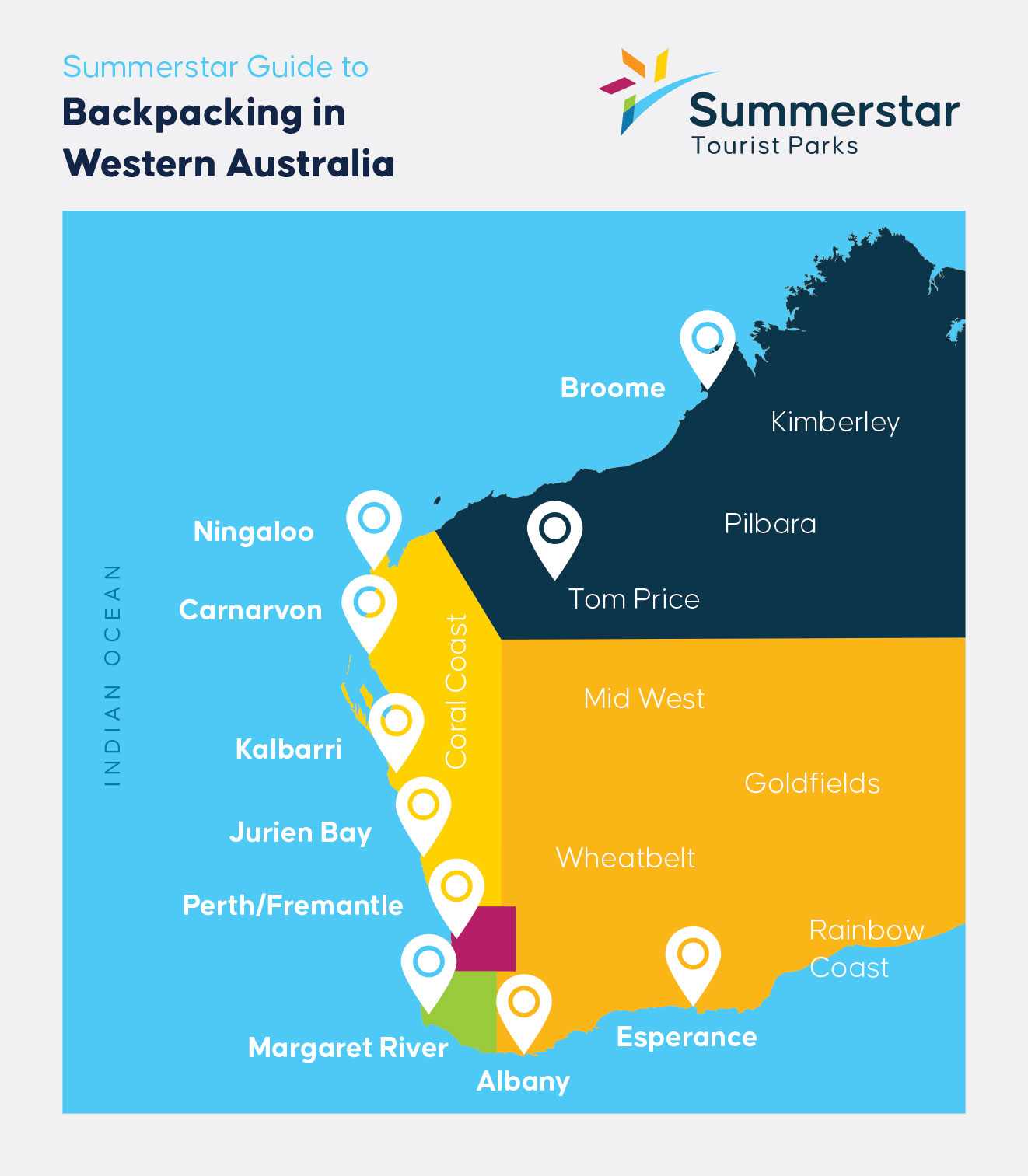
Skip ahead:
• Flying
Qantas and budget carrier Jetstar fly from all capital and many major Australian cities into Perth, and soon to Busselton-Margaret River airport. Direct flights to Broome, the ideal kick-off point for seeing the North West and Kimberley region, fly in from Brisbane, Darwin, Melbourne and Sydney.
Jetstar and REX also offer regional connections traversing some pretty large distances within Western Australia.
You can fly to Perth on a number of direct flights from the UK, Middle East, South Africa, New Zealand and Asia.
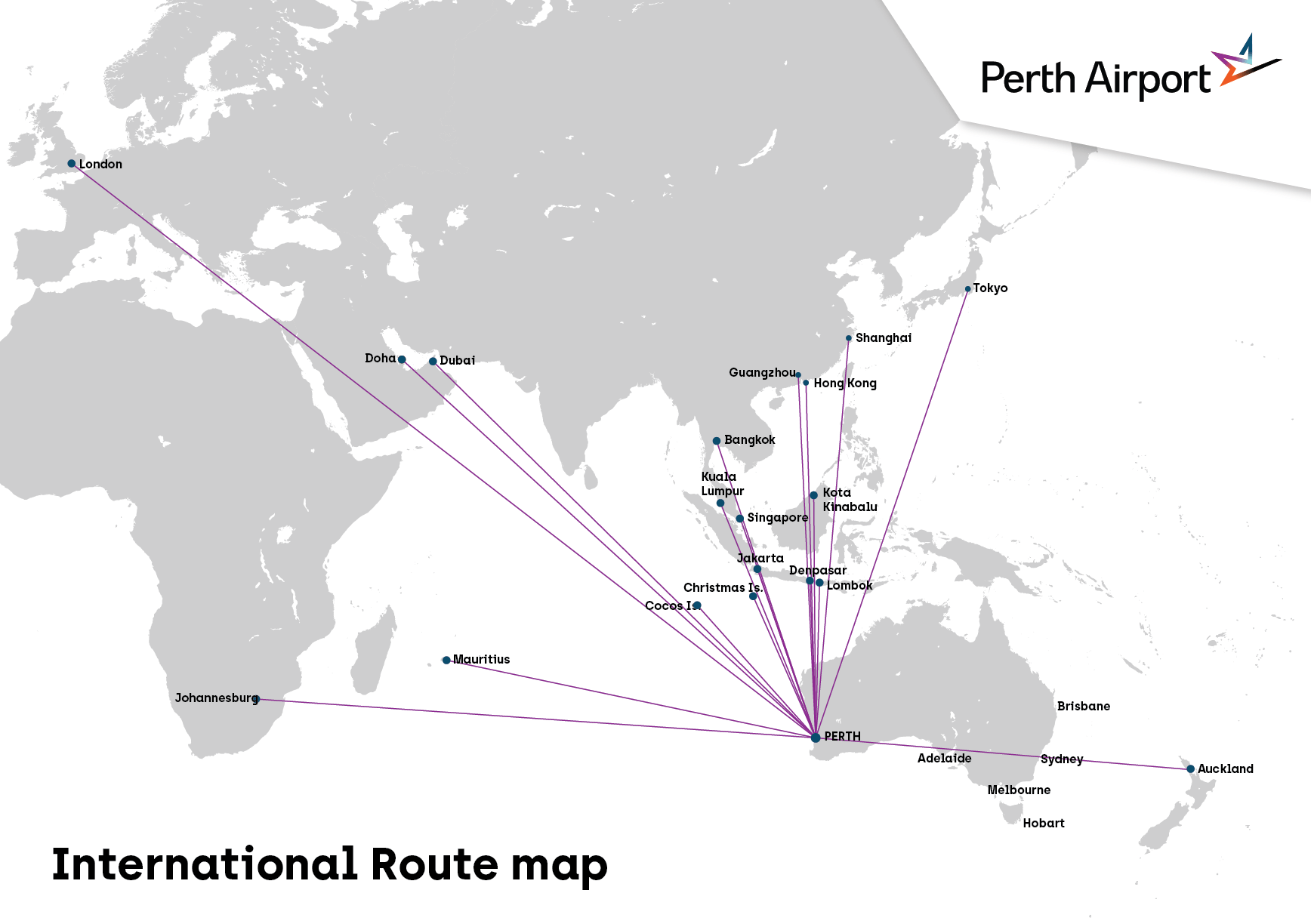
Image credit: Perth Airport.
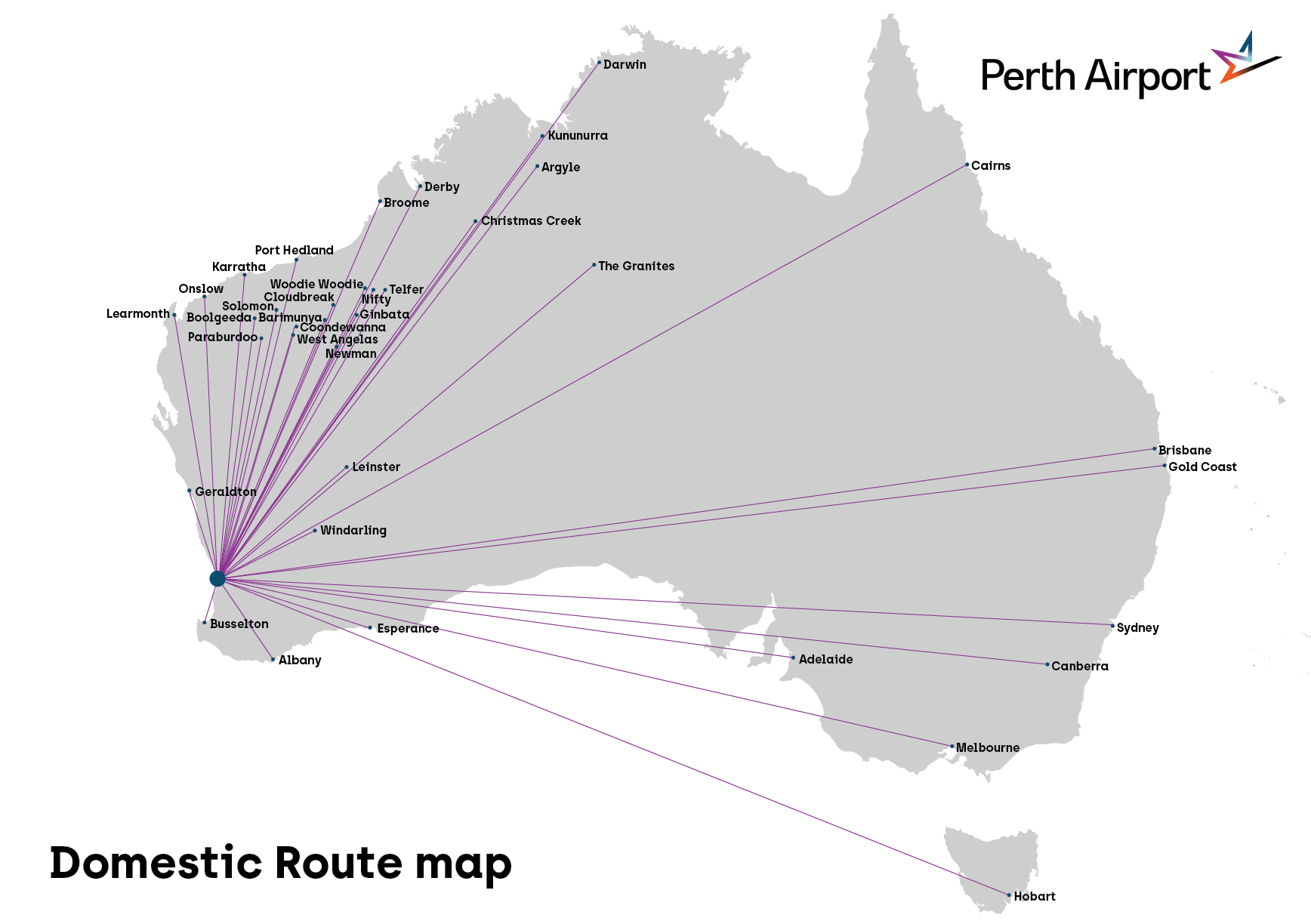
Image credit: Perth Airport.
• Driving
While flying into Western Australia is the most common way, driving is a great option too, especially if you’ll be parlaying that into one of the many great Western Australia road-trips to see up close the diverse and unique remote and rural landscapes!
Popular road-trip worthy routes connecting Western Australia to the other side of the country are;
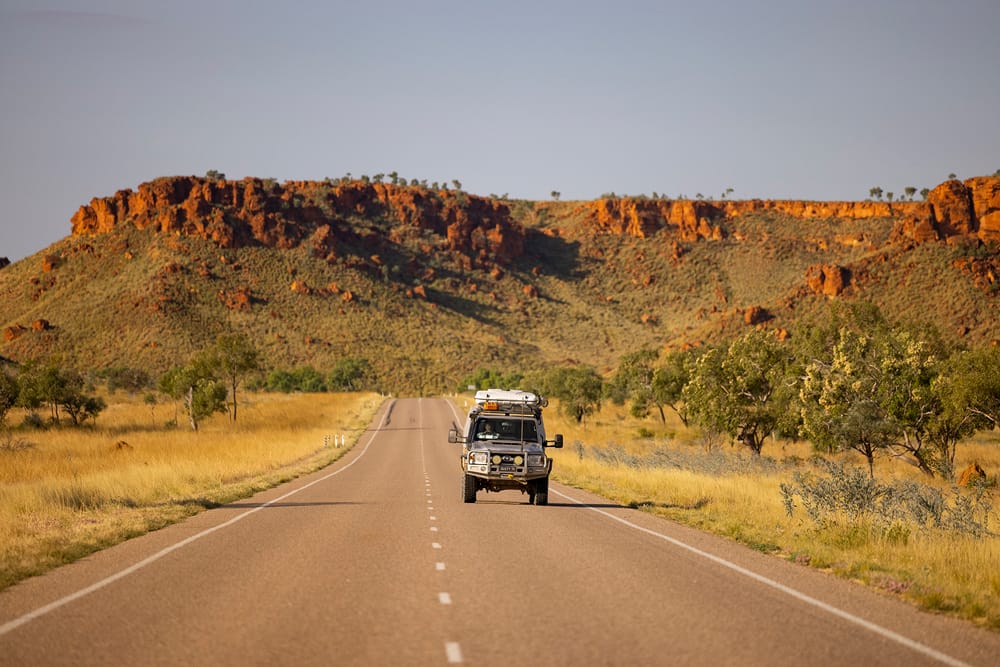
Driving the Gibb River Road, Kimberly, Western Australia. Image credit: Tourism WA.
At roughly four times the size of Texas, the state of Western Australia is extremely large and has diverse geographic characteristics. Of course, this just means there’s a lifetime supply of things to see! These features and the large distances are what makes the state incredible, what with so much space to roam. But they also pose risks and care should be taken to ensure a safe and enjoyable backpacking trip in Western Australia.
Planning on tackling the open road? Check out our Road Trip Essentials: What To Pack.
Driving around Western Australia is super popular with backpackers, and here are tips and considerations to keep in mind when driving around Western Australia:
If you’re leaving major roads to see some of WA’s best off-road tracks, a 4WD will be necessary. Prepare yourself with knowledge of the terrain you’ll be tackling, the skills needed to handle extreme conditions, terrain and weather.
Here’s another handy top; track down the best fuel prices with the below apps;
Western Australia has affordable metro and regional coaches and passenger trains servicing more than 240 Western Australia locations including many of the top destinations and landmarks.
Often backpackers hire a car, van or camper, or book a tour to get to some of the more remote attractions and destinations. Western Australia’s coaches are comfortable, designed for long-distance travel, have an onboard toilet, entertainment and room for luggage.
• Transport:
• Hitchhiking in Western Australia:
Hitchhiking is illegal in Australia.
For backpacker accommodation Western Australia has lots to offer, from some higher-end luxury offerings if you’re looking to splurge, along with glamping, guesthouses, bed and breakfasts, pubs, couch surfing, campgrounds, caravan and tourist parks.
The Summerstar network of family-owned caravan and tourist parks offer fantastic affordable accommodation options such as cabins, powered/unpowered camper, caravan and campsites, all located in some of the most beautiful and backpacker-friendly locales in the state.
Backpacking around Western Australia means one thing, you’ll probably be experiencing firsthand some extreme distances involved in backpacking, road-tripping and walking and hiking throughout the state. You’ll be rewarded along the way with bountiful experiences from the people you’ll meet, friends you’ll make, things you’ll see, eat and drink!
We might be slightly biased, but Western Australia’s beaches are the best in Australia and are truly world-class. Walking, surfing, snorkelling, four-wheel driving, scuba diving, fishing, windsurfing, standup-paddle boarding are just some of the popular activities on offer at Western Australia’s beautiful coastline.
With the ideal climate most of the year you’ll have the backpacking trip of a lifetime exploring Western Australia’s coastlines and beachy lifestyle. All beaches in Western Australia are free to visit, and many have the red and yellow flags letting you know where is safest to swim, along with lifeguards patrolling during the summer months. Certain beaches allow driving and camping, but not all.
Think of Western Australia as broadly divided into five major regions, with plenty of transport options for getting between them. Up north, you’ll want to take a North West road trip and hit the very wide open roads of the state’s North West coastline, islands, deserts and forests of the Kimberly, Karijini and the Pilbara.
The Coral Coast, with its white sandy beaches and turquoise water, connect the popular backpacking townships and cities of coastal Kalbarri, Carnarvon, Geraldton, Jurien Bay and others.
Western Australia's capital city Perth, and surrounding destinations Fremantle and Rottnest Island offer multitudes of attractions and work opportunities for backpackers, along with the nightlife and hostel options of a large and cosmopolitan city.
Down south you’ll be exploring more world-class beaches, trekking through ancient tall forests, and maybe even picking up work in the local tourism or winemaking industries.
Broome is an ideal focal point on any Western Australian backpacking trip and will be your kick off point for multi-day, even multi-week, trip through the vast north of the state. There are highlights aplenty such as Cable Beach right near town, the Dampier Peninsula, as well as the can’t miss, and very vast, areas of the Kimberly Region, Karijini and the Pilbara. The landscape of the North West and beyond traverses white sand to red desert, waterfalls, gorges and canyons, there’s truly a lot to discover.
Hit the wide-open road and visit must-see towns and roadhouses, traverse uniquely Western Australian landscapes filled with gorges and ancient rock formations. Backpackers visit this remarkable region to explore the freedom of wide-open spaces and infinite starry night skies, learn about the region’s ancient history and Indigenous culture.
The distances between towns in the North West are massive, careful planning and preparation are a must. You’ll often be on unsealed roads, miles from help. We did say it’d be an adventure!
The weather up in the top-end can be unpredictable, the best time to visit is during the dry season (May to October). The wet season is from October to April and is known for stifling humidity, thunderstorms and flooding throughout the Kimberley.
The perfect time to visit Broome and Cable Beach is July to September, as this is the optimal Cable Beach swimming season with waters cleared from the jellyfish which appear during the wet season.
Plan ahead and be prepared to camp if you get stuck or turned around.
• Broome & Cable Beach
Famous for sunsets, and one of the top beaches in the country. What is one must do Broome activity? Ride a camel down Cable Beach at sunset, one of the most sought-after experiences in Western Australia.
Broome & Cable Beach highlights:
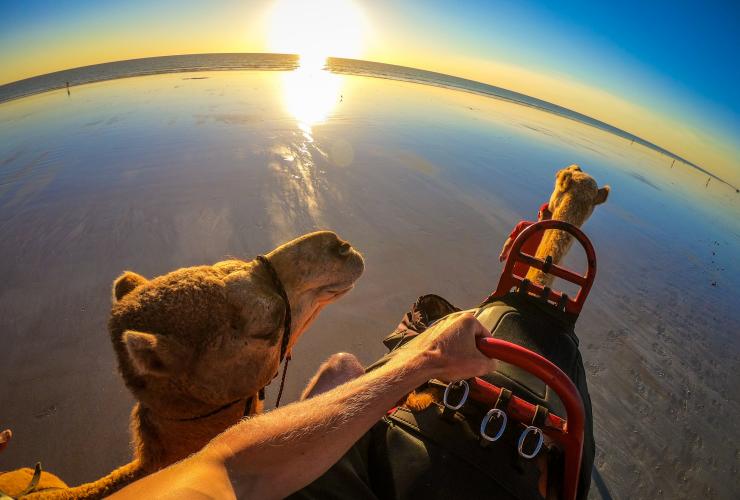
Cable Beach, Broome, Western Australia. Image credit: Tourism Australia
• Bungle Bungle Range
No trip through the Kimberly is complete without experiencing the UNESCO World Heritage-listed Purnululu National Park, and the iconic tiger-striped, beehive-shaped rocks of the photogenic Bungle Bungle Range.
If you can splurge, taking in this amazing site from the air is a once-in-a-lifetime thing, however, it is still possible to take in on a backpacker budget too. There are trails ranging from short strolls to overnight hike-in treks, and self-guided and organised tour options.
A 4WD is required to self-drive to Purnululu National Park.
Bungle Bungle Range highlights;
• Pilbara
At twice the size of the UK, the Pilbara region covers a diverse number of stunning destinations from beautiful national parks to pristine coastline and islands. The Pilbara is the focal point of Western Australia’s mining industry, but there are tons more to this region than that.
Pilbara highlights:
• Karijini National Park
Western Australia’s second-biggest national park, the iconic Karijini National Park is nestled in the Pilbara region about 660 kilometres from Exmouth, 850 kilometres from Broome, and 1,400 kilometres from Perth. The park is also roughly 100km from Tom Price, making for a perfect central location when exploring the Pilbara region. Check in to Tom Price Tourist Park which is a great base for exploring nearby Karijini National Park.
If you’re entering Karijini National Park from this direction you’ll notice Mount Bruce (Punurrunha), Western Australia’s second-highest peak. The 10km hike affords great views of the surrounding Pilbara region.
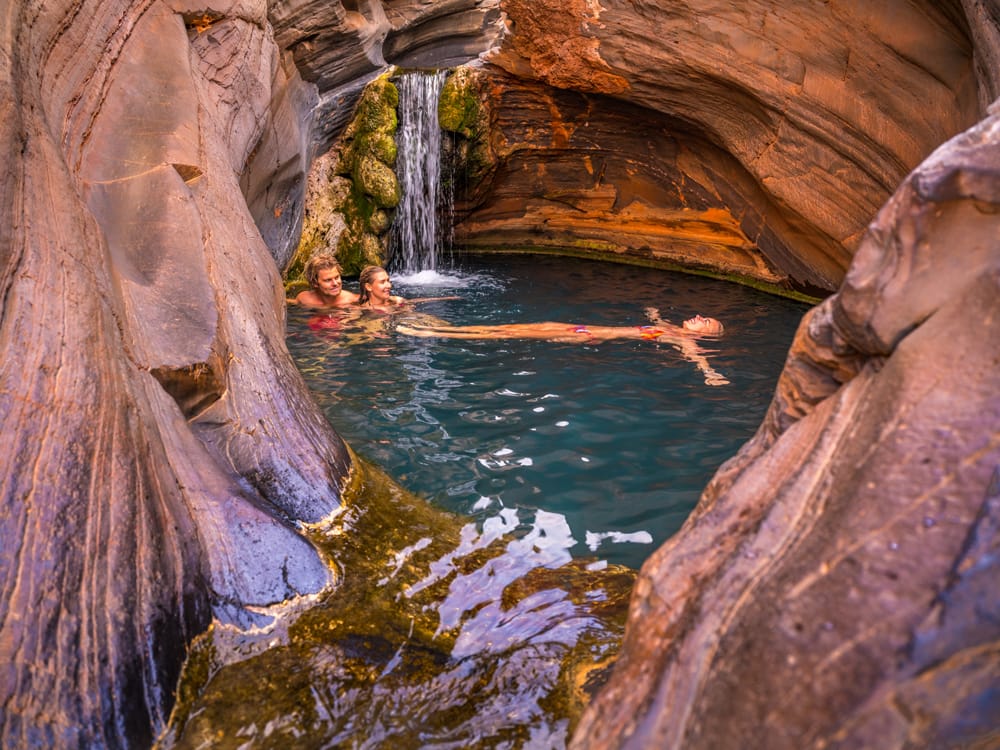
Cooling off at Hamersley Gorge, Karijini National Park. Image credit: Tourism WA
Karijini National Park is dotted with rusty-red gorges, refreshing waterfalls and rock pools to swim in, and unique Australian wildlife, all explorable on well-defined walking and hiking paths and trails.
Karijini highlights:
• The Kimberly
Venturing into the Kimberly from Broome along highway 1 you’ll go through Fitzroy Crossing, which is a perfect pitstop. Danggu Geikie Gorge National Park is a 15-minute drive from the town centre.
The scenic east Kimberly the town of Kununurra is home to the annual Ord Valley Muster, an event well worth planning on being in town for. The 10-day event is held at the beginning of winter, a delightfully warm time of year.
The Kimberly highlights:
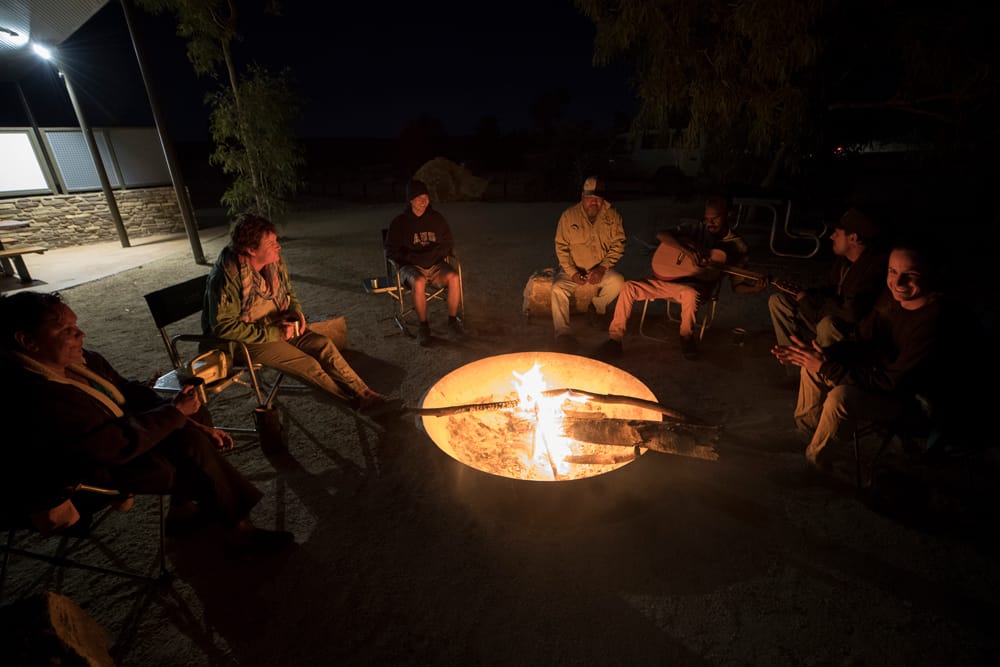
Camping at Mimbi Caves, Fitzroy crossing. Image credit: Girloorloo Tours/Tourism WA
• Dampier Peninsula
Dampier Peninsula spans the area north of Broome and is famous for the scenic red landscape clashing with the white sandy beaches and clear turquoise waters. The road in is sealed however a high-clearance 4WD will still be needed in order to leave the sealed main road, or to drive onto the beaches.
Powered and unpowered camping is available at the working Cygnet Bay Pearl Farm, on the Dampier Peninsula, as well as more luxurious accommodation options.
Dampier Peninsula highlights:
• Rowley Shoals
Nearly 300km off the coast of Broome, Rowley Shoals is an ocean wonder unlike any other. It ticks all the boxes for people who are into diving, snorkelling and fishing in remote or out-of-this-world destinations along the great west coast. We suggest checking into Broome Caravan Park and getting to Rowley Shoals by boat charter, or book a diving, snorkelling or fishing tour.
Rowley Shoals highlights:
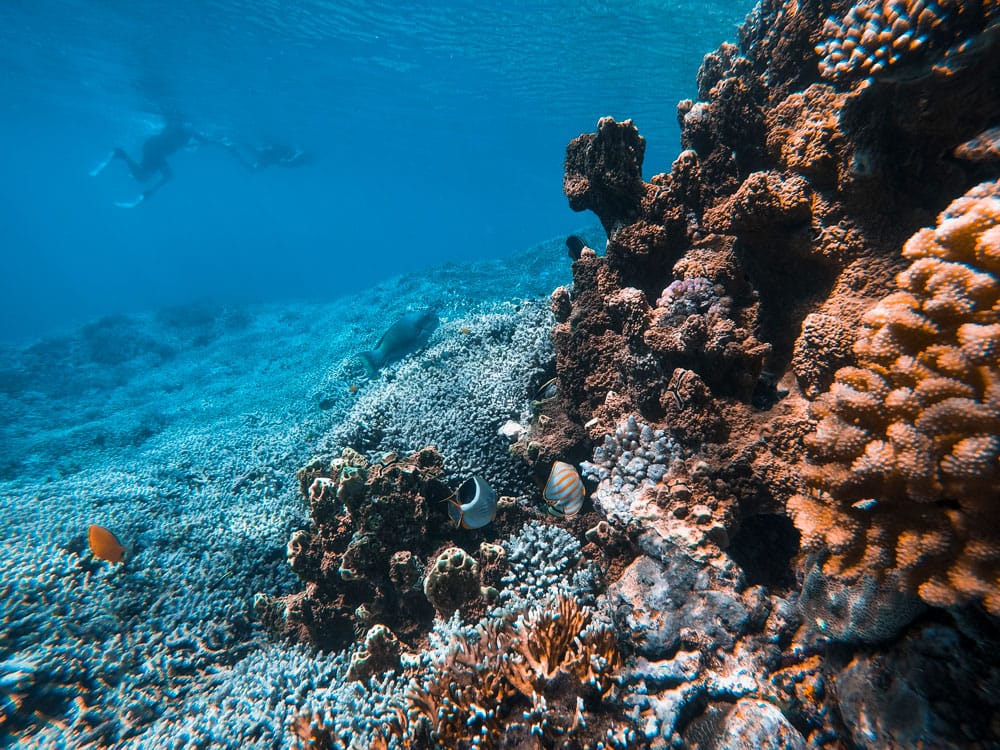
Some of the best snorkelling and diving in Western Australia at Rowley Shoals. Image credit: Tourism WA
If you prefer sleeping in a tent or if you’re travelling in a caravan, Broome Caravan Park has campsites that will take care of all your needs. The Caravan Park also offers park homes and chalets if you require more amenities.
Camping in Broome CBD is not allowed. Camping is available at remote stations along Gibb River Road and other major towns such as Fitzroy Crossing and Kununurra.
Your best bet is a 4WD, if you venture off Highway 1 almost all roads will be unsealed, including the Gibb River Road and the road to Purnululu National Park. Consider a satellite phone as you will be out of mobile phone reception most of the time outside of major towns.
Western Australia’s famous Coral Coast spans 1,100km of breathtaking coastline from Cervantes, two hours north of Perth, to the World Heritage-listed Ningaloo Reef. The Coral Coast Highway conveniently stitches these incredible destinations together, with numerous backpacker budget-friendly destinations to entice you along the way as you backpack up the coast.
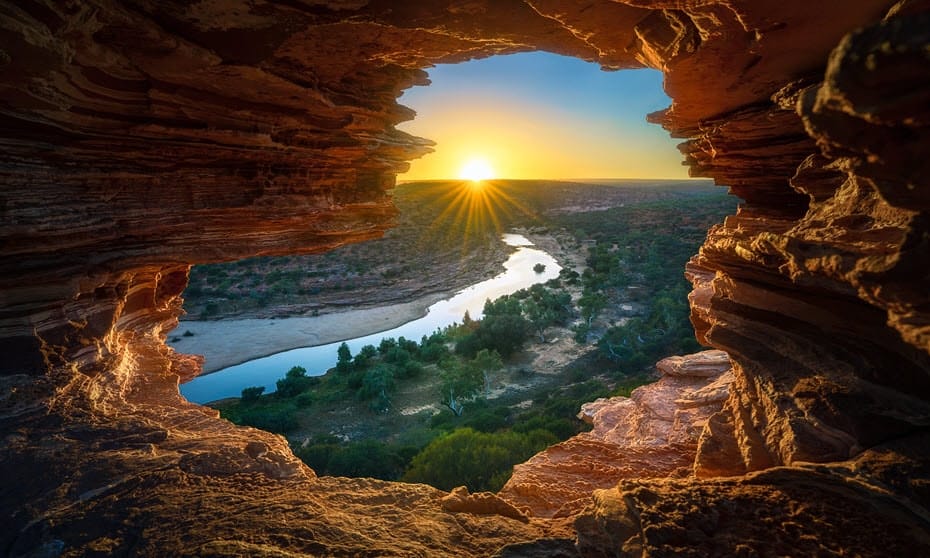
Nature’s Window photo spot at Kalbarri.
• Ningaloo Reef
The Coral Coast near Exmouth is home to some of the world’s most unique and diverse marine habitats, including the famous Ningaloo Reef. The world’s largest fringing reef boasts opportunities to encounter the elusive whale shark and from July to October you can spot the ‘humpback highway’ as these gentle ocean beasts migrate along the West Australian coastline.
Ningaloo Highlights:
• The Pinnacles
At Nambung National Park the rugged Pinnacles Desert is by far one of Western Australia’s most fascinating natural attractions. The naturally occurring limestone column-like pillars rise from the sand and range from roughly 1 metre up to 3.5 metres in height, and there is some mystery about how these unusual shapes were actually formed.
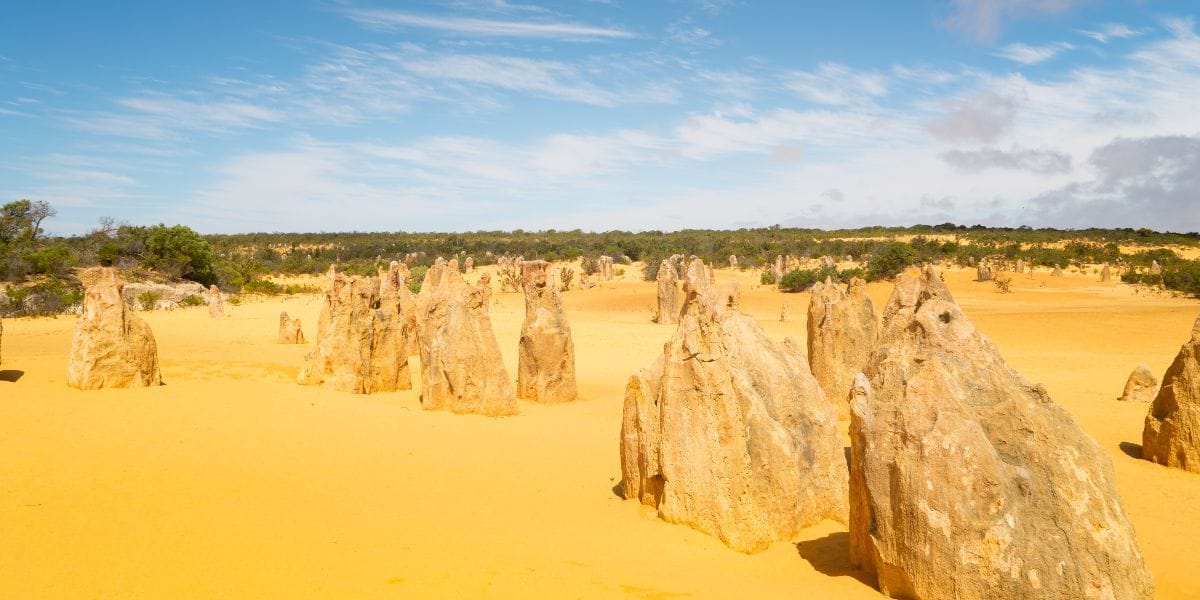
‘The Pinnacles’ at Nambung National Park.
• Kalbarri
Kalbarri is one of the places you can't miss on a WA backpacking trip. It’s warm all year and has numerous natural attractions and incredible landscapes which make it famous and well worth a visit. Migrating whales are often spotted right off the beach at Kalbarri Red Bluff Tourist Park.
Kalbarri highlights:
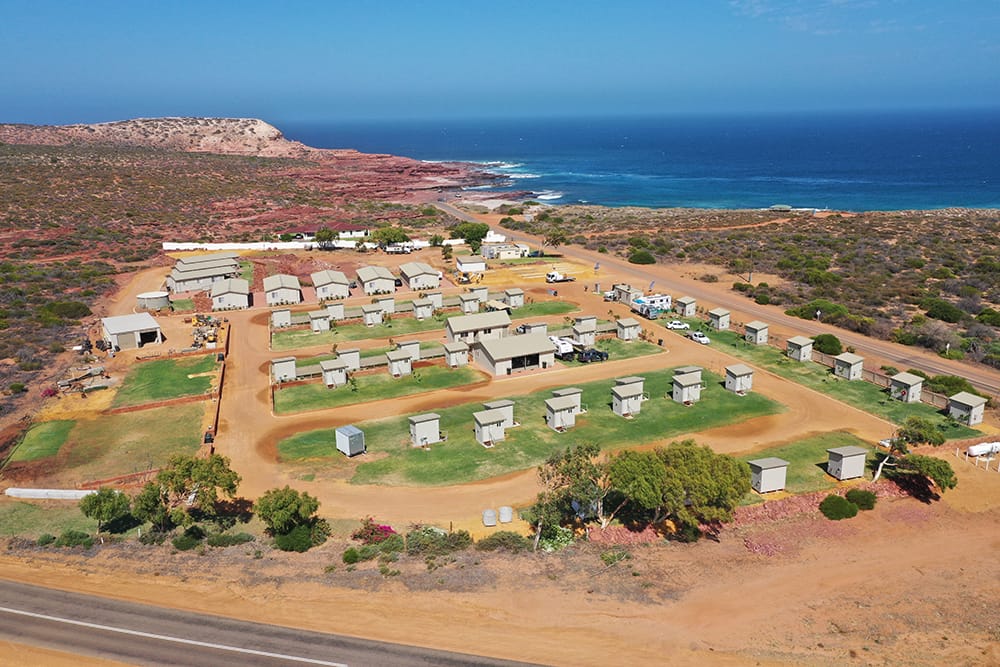
Camping right on Red Bluff at Summerstar Kalbarri Red Bluff Tourist Park.
• Shark Bay World Heritage Area
Your backpacking adventure through the northern Coral Coast will lead you to The Shark Bay World Heritage Area, which shouldn't be missed. It is about 800 km north of Perth, and around an 8½-hour direct drive from Perth to the town of Denham, the entry point to this UNESCO World Heritage Area.
With perfect weather seemingly all the time, beaches galore (one is over 1000km long!) seeing this region will probably change your life. If it’s not on your backpacking bucket list - put it on.
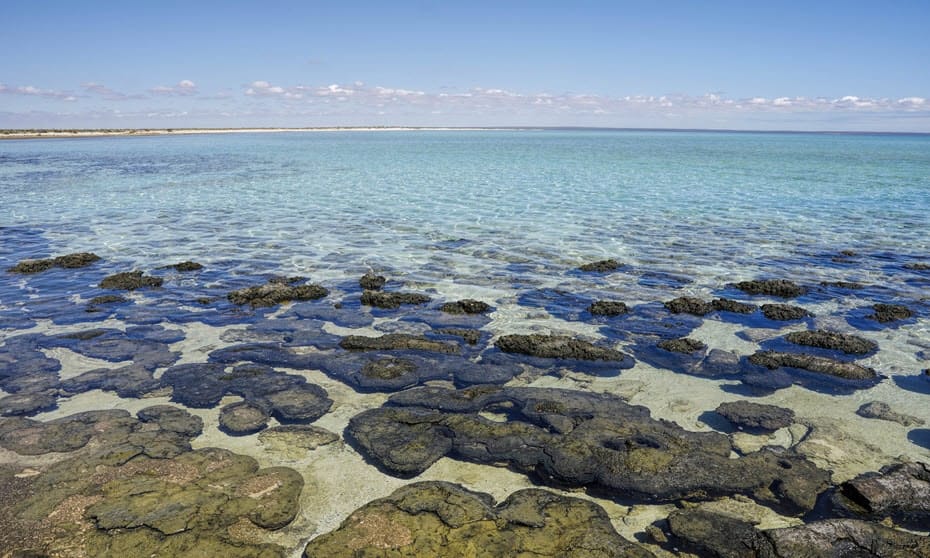
Hamelin Pool at Shark Bay.
• Monkey Mia
The place to go for seeing wild bottlenose dolphins up close. Sightseeing opportunities abound in this neck-of-the-woods: take in the area’s white-sand beaches contrasted against rust-red dunes, plentiful marine life such as turtles, dolphins, manta rays, whales and dugongs that swim the crystal clear waters.
• Geraldton
There are a great number of things to do in Geraldton. Immerse yourself in the coastal city’s street art and local bar and café scene, or just go swimming at the beach. The drive from Geraldton down the coast to Perth is one of the top road trips in Western Australia.
If your budget extends to it, Geraldton is the stepping off point for exploring and diving the wondrous Abrolhos Islands.
Geraldton highlights:
• Kennedy Range National Park
Located in the Gascoyne region of Western Australia, the Kennedy Range National Park lies around 830 kilometres north of Perth and approximately 150 kilometres east of Carnarvon. This national park is for 4WD adventurers, keen campers and those looking to get on some amazing hiking and walking trails.
• Jurien Bay
A popular laid-back beachfront holiday and fishing destination, there are lots of perfect beaches, attractions and towns to stop at and experience along the way north or south of Jurien Bay.
Jurien Bay highlights:
• Wildflower season
See our in-depth guide to Western Australia’s vast wildflower season, which sweeps right the way through the state North to South, from July to October. It makes a fantastic theme for a rural road strip as you stitch your itinerary together between all the best towns and spots for viewing this annual spectacle.
Many regional and central towns also run festivities to celebrate the wildflower season offering a range of tours and free scenic walks to travellers. Wildflower season is a great time to backpack around Western Australia.
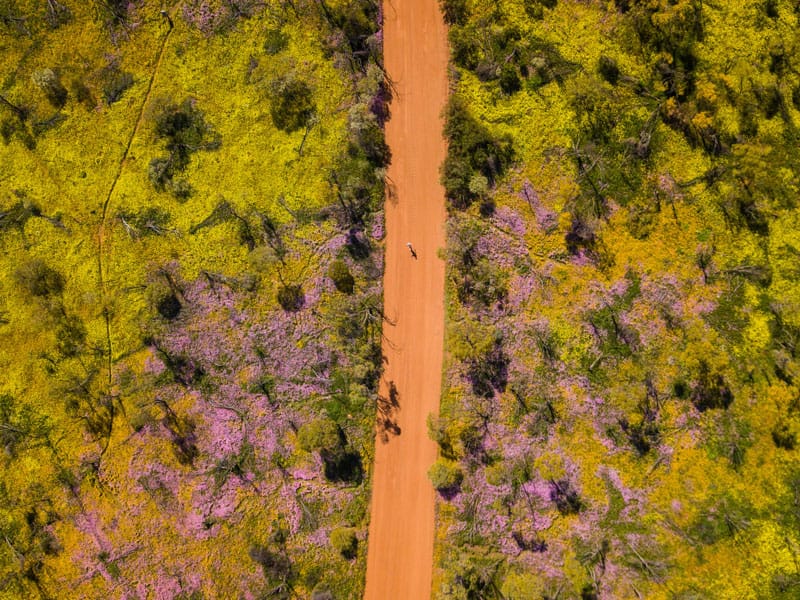
Western Australia’s wildflowers season. Image credit: Tourism WA.
• Kalbarri Red Bluff Tourist Park
Located along Red Bluff Beach Road in Kalbarri, Kalbarri Red Bluff Tourist Park is located right on the very edge of Red Bluff Beach, complete with stunning views of the Indian Ocean, and sometimes even the migratory whales. Close to the well-known Kalbarri National Park, meaning you can take in both the beach life and forest life to their fullest.
• Horrocks Beach Caravan Park
Beachside Horrocks Beach Caravan Park is situated between Kalbarri and Geraldton. The vibe is relaxed, with a palpable slower way of life.
• Geraldton Belair Gardens Caravan Park
Waterfront Geraldton Belair Gardens Caravan Park has breathtaking views of the ocean whilst being close to local attractions of the regional hub of Geraldton.
• Jurien Bay Tourist Park
Jurien Bay Tourist Park is just a stone’s throw away from the beach and is located at the foot of the iconic Jurien Bay jetty and surrounding parkland and beaches.
Perth, WA’s perpetually booming capital city, and coastal little-sister Fremantle on the mouth of the Swan River will get you your urban fix with all the bars, restaurants and nightspots you could want from a sophisticated city.
Perth is a vibrant and modern city, and so while your budget won’t quite stretch as far, there are plenty of budget-conscious options and ideas. If it all gets a bit much, some of the best beaches are a cheap public bus or train stop away anyway, and the sweeping Swan River with its miles and miles of riverside parkland and walking paths are always on-hand.
Heading out the Great Eastern Highway also takes you through the hills with its scenic network of walking, mountain biking and wildflower trails.
• Perth
Many hostels, pubs and clubs in Perth, especially in Northbridge and Fremantle, offer backpacker deals and specials, so always ask.
A lot of hostels are located in and around Northbridge, and there are cheap eats to be found. Northbridge is the place to go for bars, pubs, and many of Perth’s nightclubs.
There are many free and low-cost activities to do in Perth. Get around on the free CAT buses, there’s always something going on at the Northbridge Piazza and Cultural Centre out front of the incredible new WA Museum Boola Bardip - where entry is free.
Perth highlights
• Fremantle
The historical portside city of Fremantle is mid-revival, with several major civic developments recently or soon to be complete. Connected to Perth by the public train, there are lots of interesting accommodation options, and a vibrant cafe and nightlife culture.
Fremantle highlights:
• Rottnest Island
Rottnest Island (or ‘Rotto’) is a stunning island and a perfect day trip from Fremantle. Pack food and take in the ridiculously good beaches, surfing, snorkelling and diving spots.
Rottnest Island highlights:
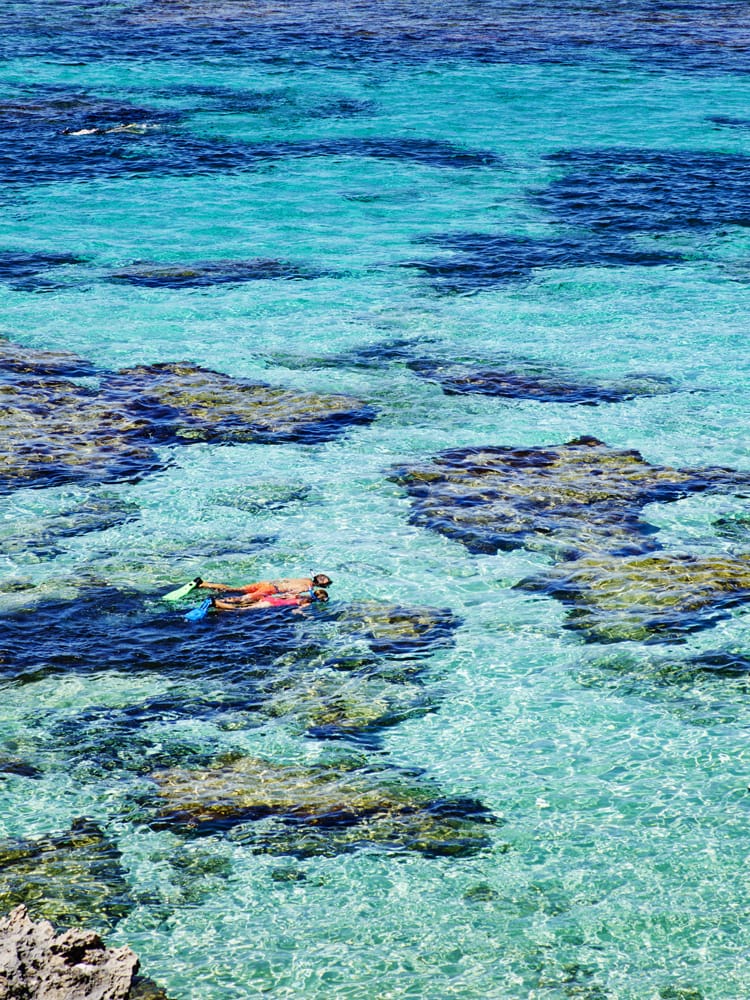
Snorkelling Rottnest Island, off the coast of Fremantle. Image credit: Tourism WA.
• The Old Swan Barracks
Winner of Best hostel in WA, situated inside a State Listed Heritage Building and opposite the brand new museum. The Old Swan Barracks hostel is central to the major train and bus stations.
• Fremantle Prison Hostel YHA
The Fremantle Prison YHA is a modern hostel situated inside Fremantle’s converted historical prison.
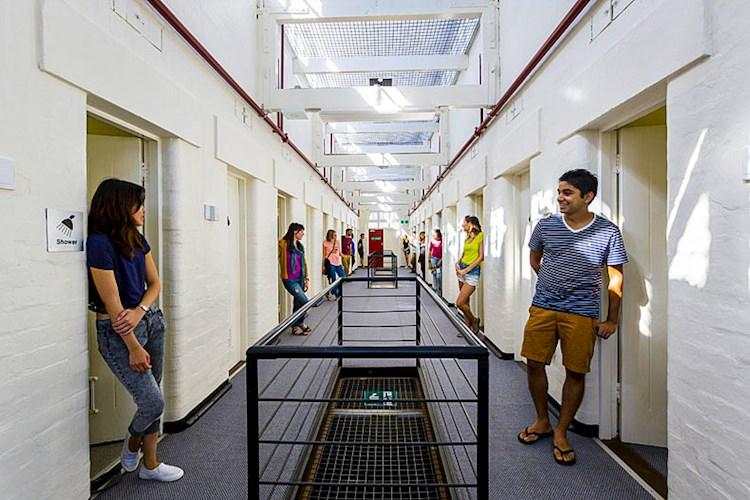
Image credit: Fremantle’s Prison Hostel YHA.
The Busselton, Geographe Bay, Leeuwin Naturaliste Ridge and Margaret River (Margs) regions are very popular backpacker destinations. You will hear people saying they’re escaping “down south” during the warmer months for some spectacular scenery, and the best weather you can pretty much ask for.
Margaret River is a major drawcard and the central jewel of the South West, and there are lots of things to see and do in the area. The town of Margaret River is in the middle of all that makes the South West special: the wilderness, its namesake nearby world-class winemaking region, breweries and the world-class surf spots to the west. The region is the focal point to the excellent South West wildflower season too.
Backpackers travel to visit this region to see the stunning countryside, beautiful drives and walks, Margaret River caves, to go mountain biking on one of the local trails and much, much more. There are lots of accommodation options to suit all backpacker budgets up and down the Cape.
World-renowned for some of the best wineries, breweries and local food in the world, Margaret River is an absolute dream for brunch lovers and foodies too.
• Busselton & Geographe Bay
Busselton is well known as a superb beachside holiday town, and as a central point to begin a South West backpacking trip, meandering between all the perfect beachside locales.
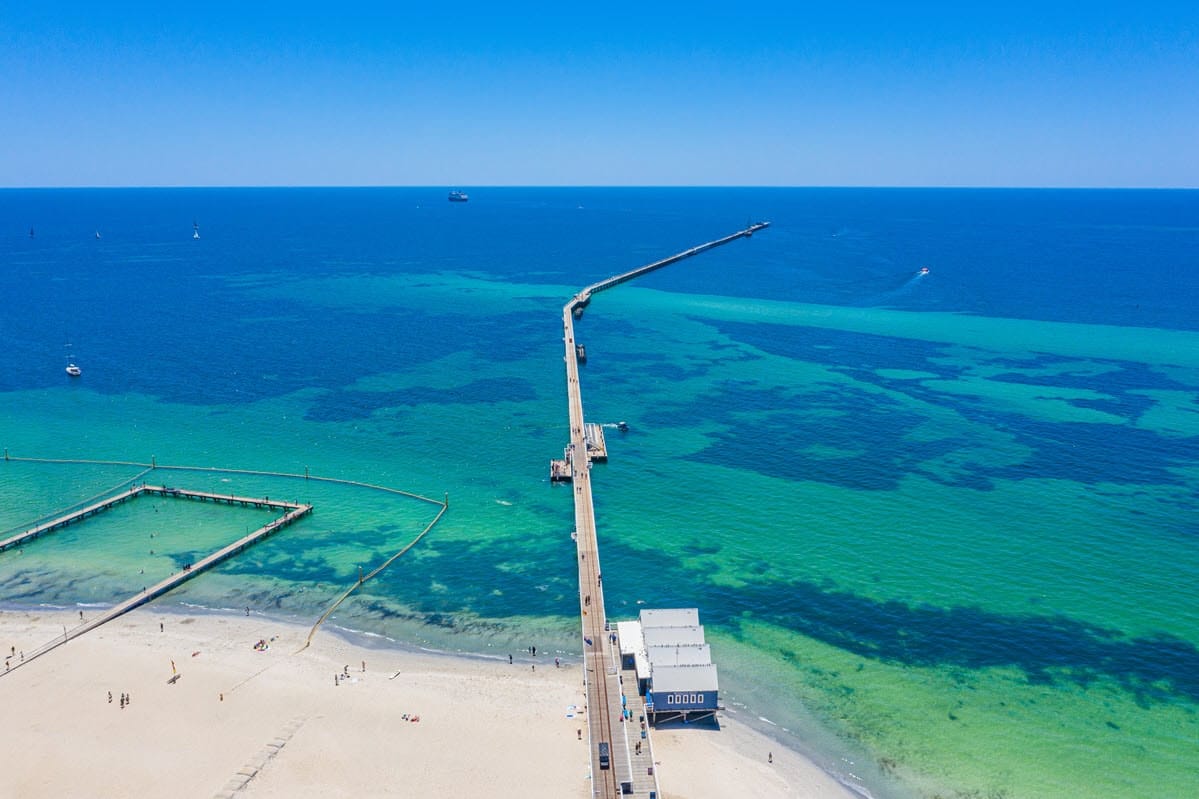
Busselton Jetty.
Busselton sits on the edge of beautiful Geographe Bay and boasts a stunning array of activity options for all budgets from snorkelling, fishing, whale watching and swimming in the crystalline waters of Geographe Bay, to explore on foot or two-wheels the bordering placid white sandy beaches, parks and coastal trails.
The city of Busselton is vibrant and has lots of dining and drinking options as well as a buzzing art gallery, cultural and entertainment scene.
Check out our extensive Busselton Travel Guide to what to see and do in Busselton and the Geographe Bay area.
Busselton highlights:
• Public Silo Trail
This permanent, open-air public ‘gallery’ links a series of rural and coastal towns across South West Western Australia by converting silos into canvases featuring amazing large scale artworks from various artists and painters.
Painted on the sides of towering agricultural landmarks, the Silo Trail has become a brilliant way of stitching together an off the beaten track South West road-trip adventure.
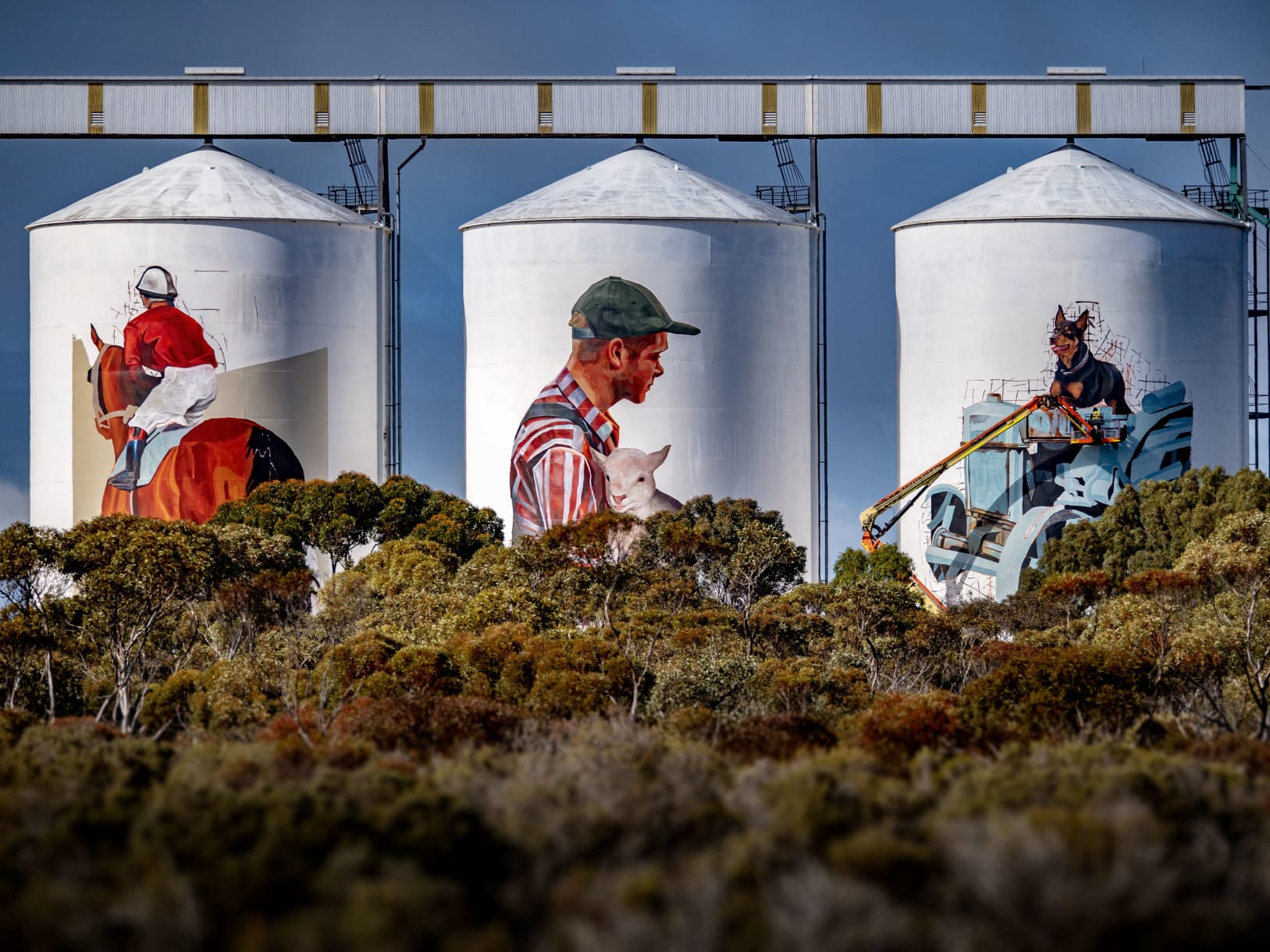
Image credit: https://www.publicsilotrail.com.
• Dwellingup
Dwellingup is a quaint and quiet town only about 1.5 hours from Perth. There is good campground accommodation, bushwalking trails and kayaking and fishing on the wild Murray River as well as a great pub and cider scene.
• Margaret River
Margaret River is a vibrant and picturesque town three hours south of Perth, known for its premium award-winning wineries and producers, exotic wildlife, and international standard big-wave surf beaches like The Box and Rivermouth.
Backpackers will love Margaret River’s craft breweries, distilleries, and cideries, so you might as well sip your way from ale to cider to craft beer. For something new to your taste buds, try chilli, ginger, or chocolate beer. While at it, sample some of the local cuisines, too.
Try your hand at the area’s favourite pastime, surfing, with a lesson from a pro at Margaret River Surf School or Yallingup Beach. Also, be sure to check out our guide to the best beaches in Margaret River.
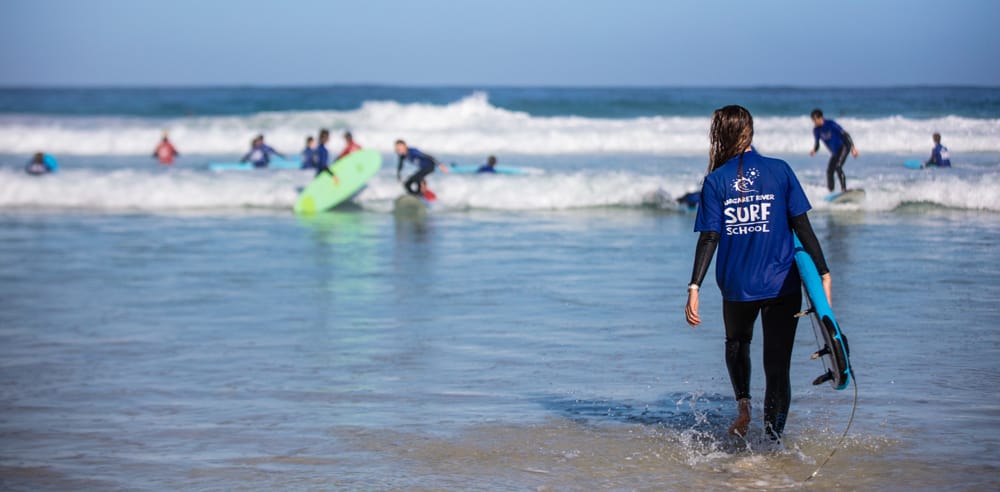
Surf school at Redgate Beach, Margaret River. Image credit: Tourism WA.
• Hiking
A brilliant way to take in the scenery of the Margaret River region is to tackle a section, or even the entire 123km of the Cape to Cape Walk Track. The track is clearly defined and marked, and runs along the Leeuwin-Naturaliste Ridge, between the lighthouse at Cape Naturaliste on the north tip to Cape Leeuwin in the far southwest of Western Australia.
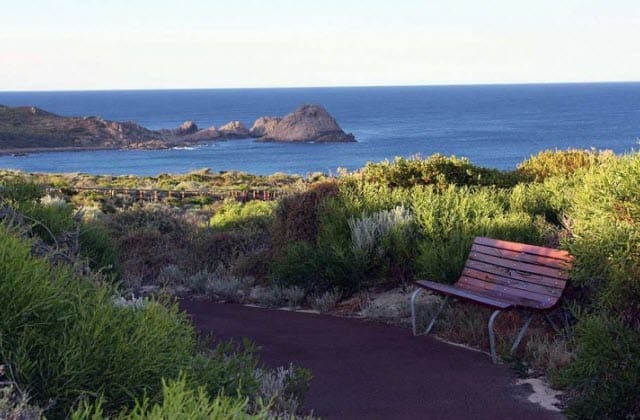
Photo Credit: Trails WA.
• Beaches
Known for its beaches, and the Margaret River Pro on the World Surf League Tour, Margaret River is famous as both a big wave surf spot drawing pros from around the world, but also for a multitude of other breaks suitable for all skill levels, including beginners.
Check out our completed guide to the best beaches in Margaret River.
Some of Western Australia’s best scuba diving and snorkelling spots are in the Margaret River region.
• Margaret River Wine Region
The much-lauded Margaret River Wine Region is home to over 200 vineyards. If you have a vehicle you should plan to head out on a self-guided tour, or book one of the great organisedrrrrrrrrrrrrrrrrrrrrrrrrrrrrrrrrrrrrrrrrrrrrrrrrrr tours of the area.
Margaret River Highlights:
• Riverview Tourist Park
Riverview Tourist Park is situated in the heart of Margaret River township. Nestled along the river’s edge and close to a state forest, this South West holiday park is ideal for those looking to enjoy all the nightlife, cafes, bars and restaurants of Margaret River’s main drag, as well as those looking to stay close to nature.
• Margaret River Tourist Park
One of the best South West caravan parks is Margaret River Tourist Park, which is found right in the middle of Margaret River, making it a perfect base to explore all that the Margaret River wine region has to offer. Margaret River Tourist Park has camping and caravan sites, cabins, cottages, and triplexes to meet the needs of backpackers and travellers of all types and budgets.
• Lazy Days Caravan Park
Lazy Days Caravan Park is located in the centre of the Busselton town centre, which is along the shores of Geographe Bay. The holiday park provides a laid back vibe for solo backpackers, families, and groups. Its range of accommodation options, designed for travellers on a budget, includes powered/unpowered caravan and camping sites, ensuite/non-ensuite onsite vans, self-contained cabins, and one- to three-bedroom holiday park homes.
No backpacking adventure is complete with significant time spent methodically exploring Western Australia’s Great South Coast region. Known for the world-class beaches of The Rainbow Coast, giant trees of famous in-land forests, diverse hiking, ocean vistas, starry nights and maritime history.
The vast inland Wheatbelt and Golden Outback is a vast region that makes for a great backpacking adventure. Pack a camper or your tent, learn some stress-free camping recipes and wander out yonder!
The region is rich with red earth, white sand, interesting goldfields history and picturesque farmlands - see work opportunities as a backpacker in Western Australia.
• Walpole
Nestled between the inlet and wilderness of Walpole-Nornalup National Park, tranquil Walpole offers beachside whale watching, camping, trekking and all sorts of outdoorsy things to do.
You can go on the Valley of Giants Treetop Walk and go for a swim in Mount Frankland National Park or the freshwater Circular Pool.
Walpole Rest Point Caravan Park has a range of accommodation options available, including holiday units, cabins and campsites.
Walpole is also a stop on the Bibbulmun Track.
Walpole highlights:
• Peaceful Bay
Adventuring down the bottom of Western Australia has a lot to offer, and beachgoing is very much at the heart of this region. Known as the Rainbow Coast, the beaches of this area are some of the best in the state. Peaceful Bay is located on Western Australia’s south coast about 30km out of the nearby town of Walpole, and yep - the name speaks for itself!
• Denmark
The town and area around Denmark is known for its hippie vibe. Enjoy the scenery at Greens Pool, hike in the William Bay National Park and take a dip at any of the fantastic beaches. Camp at Elephant Cove or stay in a more comfortable accommodation option in town.
• Albany
The city of Albany boasts rich maritime history, a rich culinary scene, and beautiful coastal scenery. The surrounding area is home to some excellent hiking trails at Torndirrup National Park, the Bibbulmun Track and the mountains of the Stirling Range.
Albany highlights:
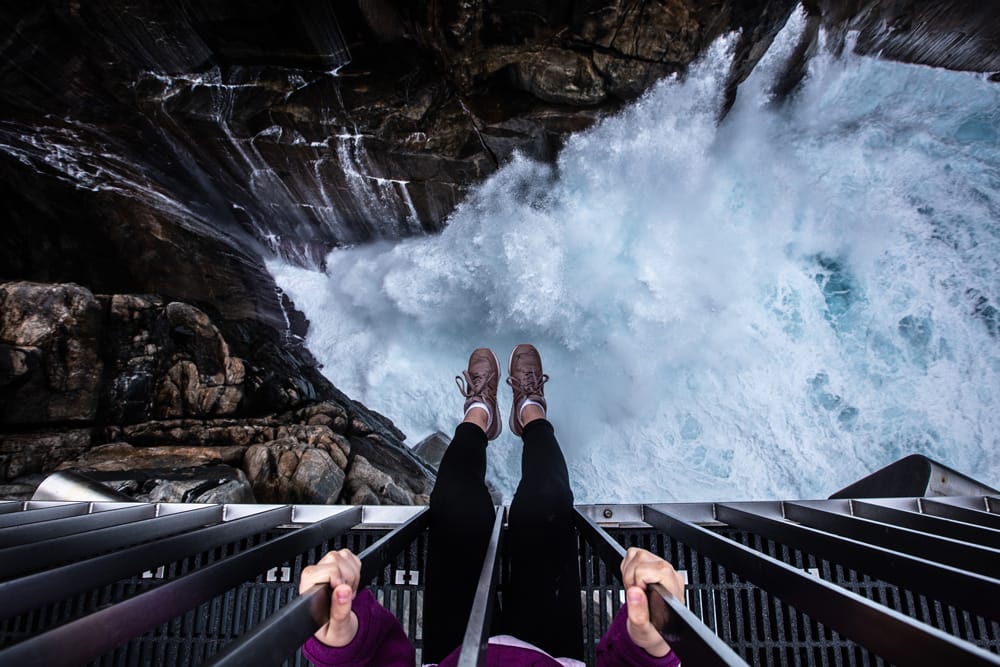
The Gap lookout, a new accessible viewing platform 40 metres directly above the surging seas. Image credit: Tourism WA.
• Esperance
A famous beachside town on the south coast of Western Australia. Take your time and enjoy the many amazing Esperance beaches, exploring Lucky Bay and the coast of Cape Le Grand National Park. Boasting a long stretch of white sand and turquoise waters, the bay is a must-see for its sunbathing kangaroos, as well as for some fun in the sun.
When you’re ready to explore further afield, you have to build the Great Ocean Drive into your itinerary, easily one of Australia's most beautiful stretches of road.
Esperance highlights:
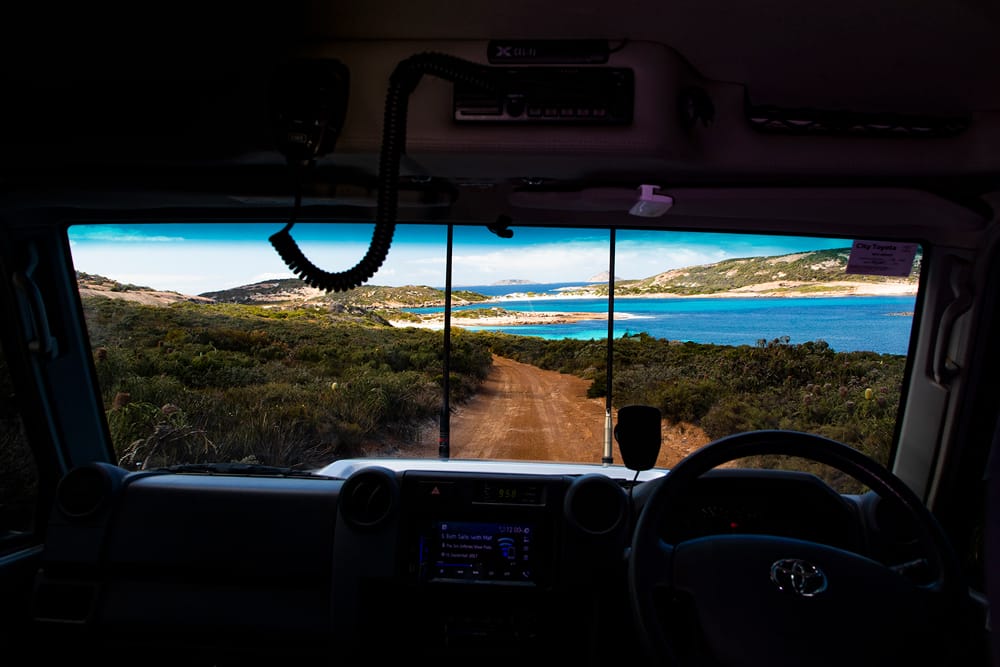
4WD to Duke of Orleans Bay. Image credit: Tourism WA.
More things to see and do:
• Wheatbelt & The Golden Outback
A vast region stretching inland from the white sands of Esperance and Lucky Bay, to the red earth and wildflowers of the interior and sprawling history-laden goldfields.
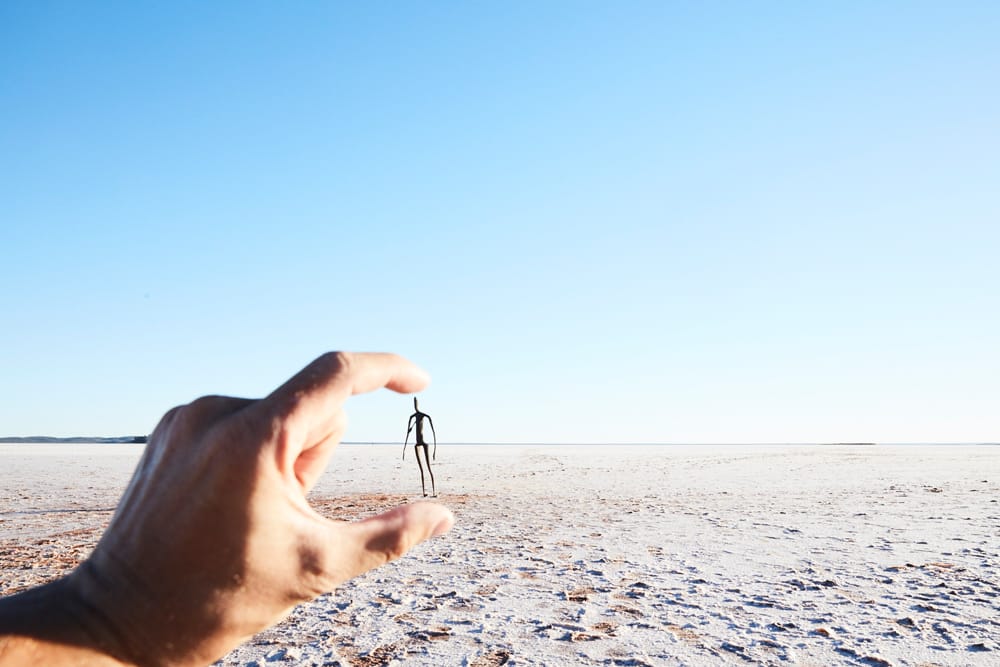
Antony Gormley Sculptures at Lake Ballard. Image credit: Tourism WA
The 965km Golden Quest Discovery Trail is available from visitors centres in the area. The companion drives also form a great basis for exploring the physically massive goldfields and Esperance region.
Wheatbelt & Golden Outback highlights:
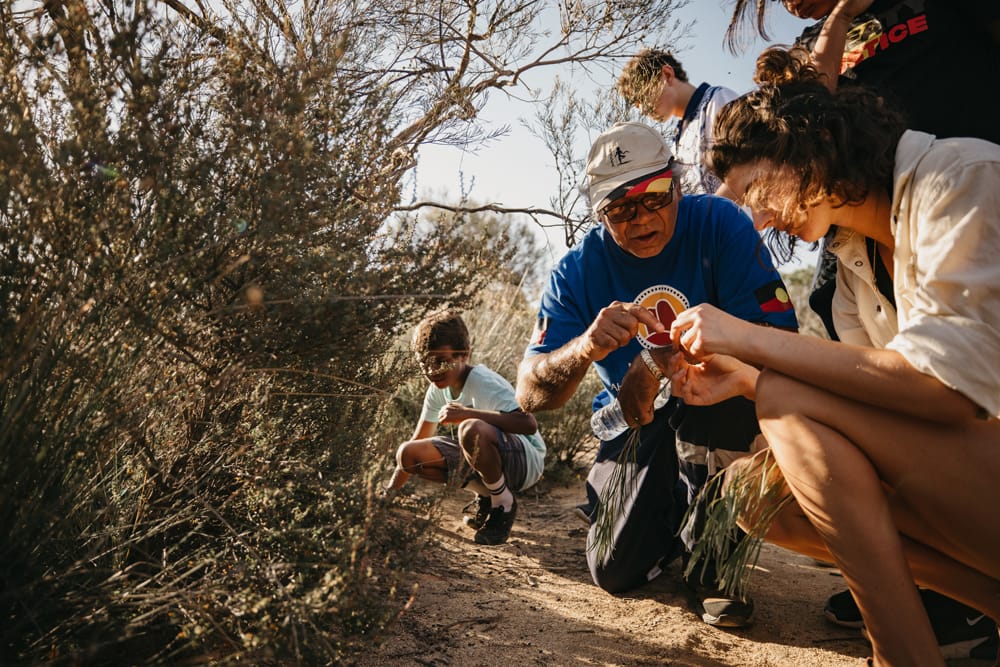
Expert local guides on the Njaki Njaki Aboriginal Cultural Tours, Merredin. Image credit: Tourism WA
If you are backpacking the South West with a camper trailer, tent, caravan, or need a cabin or unit, plan to spend some nights in a caravan park. There are plenty of holiday parks down south for every type of backpacker.
• Esperance Bay Holiday Park
Esperance Bay Holiday Park is ideally located within walking distance from the town centre of Esperance – a utopia for beach and nature lovers.
• Walpole Rest Point Caravan Park
The adventurous lot will adore this holiday park snuggled in the wilderness of Walpole. Walpole Rest Point Caravan Park is one of the finest South West caravan parks in Western Australia, with a pristine natural bush setting as a backdrop.
The Bibbulmun Track is one of the most popular long-distance walk trails in the world. Following the track gives you the opportunity to see most of Western Australia’s breathtaking backcountry. The track begins in Kalamunda, outside Perth, and meanders all the way to Albany on the south coast - the Bibbulmun Track’s sheer length is not to be underestimated.
With 49 campsites along the track, it’s a great idea to explore sections of it and use it as a basis for exploring the bottom half of Western Australia, without necessarily spending 2 months completing the trail from beginning to end.
Australia's Working Holiday Maker program: Working Holiday visa and the Work and Holiday visa.
Turning your backpacking trip into a working holiday is a great way of funding your stay, while also gaining unique work opportunities in an amazing part of Australia.
All overseas visitors to Western Australia need to obtain a working holiday visa to work in Western Australia. It is usually for 12 months however under certain circumstances can be extended to up to 3 years if you do work in an industry or region the Government considers ‘specified work’. The visa currently costs AUD$495 to apply.
Be aware one requirement of the working holiday visa is either a return ticket out of Australia or proof that you have funds to book a ticket out.
Australia offers a 12-month visa which enables young adults (aged 18-30, 35 for Canadian, French and Irish citizens) to work in Western Australia. Note that not all visas allow you to work in Australia. These visas allow you to volunteer or work in Australia in all types of employment; full-time, part-time, casual and shift work, for up to 12 months. Voluntary work is also allowed. The Working Holiday visas are not suitable for seeking permanent employment or full-time study in Australia.
Get the most current information from the Department for Immigration and Border Protection and check out the Working Holiday Visa Checklist. By the way, the content on this page is for information purposes only, please use the Australian Immigration Department’s resources and consult with an Australian qualified immigration lawyer or migration agent for the most current expert legal advice.
If you’re working, or planning on working on your backpacking trip, one of the first things you’ll want to sort out when you arrive is getting a bank account and a Tax File Number (TFN).
• Getting a TFN as a backpacker
The TFN is a unique and personal 9-digit number issued by the Australian authorities, which you have to provide your employer in order to work legally in Western Australia. Apply free online at the Australian Tax Office website, 24 hours a day and 7 hours a week, and you will need need to have an address in Australia and a visa allowing you to work or study in Australia.
• Opening a bank account as a backpacker
Most banks will set you up with an everyday account (called savings account in Australia), and it’s possible to arrange one before you arrive. You will need to provide proof of identity documentation and your visa in order to get set up. Be aware some fees will probably apply, sometimes these will get waived if a certain amount is deposited, like your pay.
Getting seasonal work in Western Australia is quite common. Work is available in numerous industries and plenty of locations. There are lots of opportunities to work in an interesting remote location and having room and board included is a great way to extend your stay, and your budget.
• The most common employment for backpackers:
• Online resources for finding seasonal work in Western Australia:
• Work program providers:
• Volunteering:
Heading on a Western Australia backpacking adventure? Here’s a guide to what to pack:
Laid-back, casual. The general rule of thumb is to dress for the weather and the season you’ll be travelling in. Pack clothing that allows for layering so you can adapt to the weather, which can vary greatly. While it’s typically warm all year round, during winter months, especially down south, it can get pretty cold.
While there are many places you’ll feel like dressing up a little, some venues won’t admit athletic wear, singlets, thongs (flip flops) etc. Check before you go.
If you’ll be participating in activities such as swimming and standup paddleboarding a good pair of wet shoes (sometimes called aqua socks) will serve you very well.
Where do I find out more on what’s going on in WA?
Find more sightseeing and entertainment ideas at:
How can I book accommodation in Western Australia?
Accommodation throughout Western Australia can be booked directly on the Summerstar Tourist Park website.